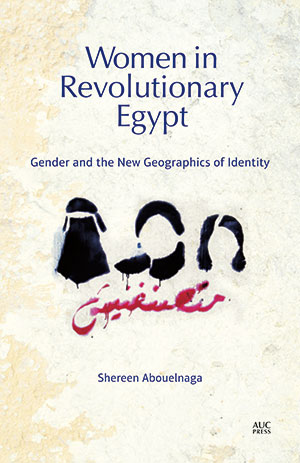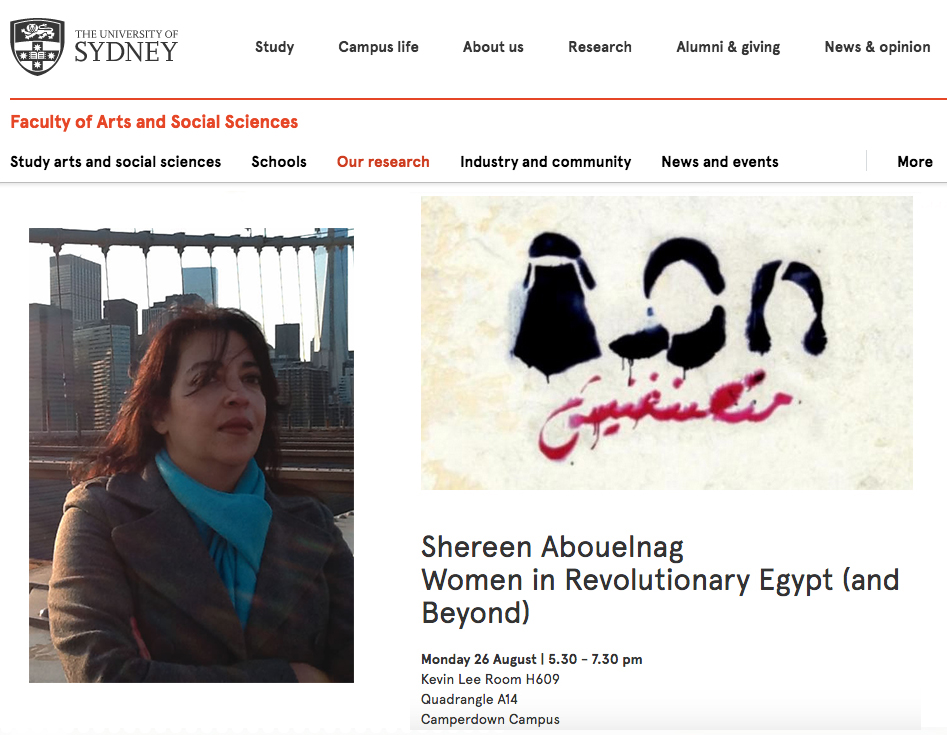Today, August 26, AUC Press author and university professor Shereen Abouelnaga is talking at the University of Sydney about her book in the context of the longer history of feminist Egyptian and international historiography on women and revolutions. She will look at how the study of feminist history questions the broader relationship between women and revolution, history and memory, between top-down politics and the micro-politics of everyday life, and raise questions whose relevance goes far beyond revolutionary Egypt.
In her compelling book, Women in Revolutionary Egypt: Gender and the New Geographics of Identity (AUC Press, 2016), Abouelnaga, an Egyptian professor of English and comparative literature at Cairo University, takes the January 2011 uprising as the point of reference to examine gender politics in post-Mubarak Egypt.
In this innovative inquiry, she explores the country’s entangled relationship between gender and nationalism, and Egyptian women’s use of artistic expression, and in particular poetry, as a form of political resistance. Abouelnaga also analyzes the paradoxical deterioration of women’s rights despite sociopolitical transformations and denounces the marginalization of women’s stories in the archives of Egypt’s collective memory.
Here is an interview we did with the author in 2016 when her book first came out.
Much has been written about Egypt’s 2011 Revolution. How is this book different?
Except for a few pieces, most of what has been written revolved around either the scene of women taking to the streets particularly in the famous 18 days or around the horrid violations that happened later, especially the abuse and sexual harassment. Women in Revolutionary Egypt fathoms all that happened not for the sake of documenting or lamenting or taking pride. The purpose is to understand how gender has become a dominant factor in the formation of the new subjectivities of men and women, and how it has become a factor that cannot be untangled from the socio-political scene. Thinking gender is not a luxury any more.
Has Egypt’s gender issue really been challenged since the country’s 25 January 2011 uprising?
 Yes indeed. Gender has always been part of the State’s image, hence, State feminism. Women have always been taken to be the cultural marker of identity. With the 25 January 2011 revolution (not uprising, definitely) the homogenous image was demolished, and the enforced silence turned into multiple voices, ideologies, images, protests, demands, and geographics. I believe it is the plurality, as opposed to singularity and monoliths that was (and still is) quite a challenge.
Yes indeed. Gender has always been part of the State’s image, hence, State feminism. Women have always been taken to be the cultural marker of identity. With the 25 January 2011 revolution (not uprising, definitely) the homogenous image was demolished, and the enforced silence turned into multiple voices, ideologies, images, protests, demands, and geographics. I believe it is the plurality, as opposed to singularity and monoliths that was (and still is) quite a challenge.
In your opinion, how does the new rising generation today understand womanhood in what still remains a rather traditionally patriarchal society?
It is impossible to talk about one new generation. Plurality is the most important outcome of the revolution. While gender has become an indispensable factor that cuts across all forms of identities, there are different constructs of it as well. That is, it has become part of the positionality and ideology taken by the subject. So we cannot talk about one understanding of womanhood. From the very beginning all positions were declared: the conservative, the liberal, the Islamic, and the radical. The main attribute that characterizes the new generations is that womanhood and gender have become part and parcel of the struggle, whether they are fighting for an Islamic state or a liberal state. Even the generation that naively supported the military rule could not dispense with the centrality of gender.
What do you mean by “the most important aspect of gender transformation in post-Revolution Egypt is that of positioning”?
The shattering of the enforced silence on gender by the Mubarak regime has allowed space for the freedom of choice, the possibility of declaring stands, and the capacity to practice identities. The latter comprises religion, class, education, color, ideology and gender. Where gender stands in this paradigm and how it affects and relates to the other factors form ‘positioning.’ These formations or rather the ability to discern them is one of the most important outcomes of the revolution since homogeneity and eradication of differences were the markers of gender previously. It was all about ‘the image of Egypt.’
As you address the question of women’s identity, you make the distinction between patriarchy and misogyny and go as far as saying that “it is highly misleading to blame patriarchy across the board” and it “does not provide a space for responsibility or accountability.” Can you explain that?
The Turkish scholar Deniz Kandiyoti has written a very illuminating piece on this issue. We have been blaming any violation of women’s rights on patriarchy but what is patriarchy? There is nothing concrete about that, it is not an autonomous visible project. In addition, blaming patriarchy renders the power relations that facilitate violations and the perpetrators of violence against women to the background. Blaming patriarchy, therefore, cannot form a sound analysis. Unfortunately, most writings about Egypt adopt this stand, and the result is a vague analysis that does not grapple with the issue of power.
In your book you say that “perhaps, one of the most naïve assumptions of the revolutionaries was that gender relations were to be reenvisioned automatically as a result of demolishing the hegemonic patriarchy, the president [Mubarak].” How was that shortsighted?
All assumptions were shortsighted. The belief that ousting Mubarak meant the birth of a new Egypt was not only naïve but also shortsighted. Similarly, and since we agree by now that gender cuts across all other factors of identity, we thought that gender constructs were to be transformed miraculously. How sad! You cannot expect any transformation of gender without the transformation of the socio-political infrastructure. They are both entangled, and any attempt at disentangling them will take us back to the discourse of state feminism.
Why do women’s rights get tied into politics of nationalism?
Any autocratic regime resorts to a high-pitched tone of nationalism to consolidate its power. Along with that, women’s rights and citizenship become the ideological declarative sign of this regime. Women’s rights are not only the marker of the regime but also the terrain on which loyalties and disloyalties take shape. Therefore, it is not surprising that during the short Islamic rule of Morsi women became the arena of extreme polarization. We used to hear terms like ‘our women’ and ‘their women.’ All binarisms were enacted on women’s rights and citizenship. In short, all parties were dragging us back to be the cultural markers of identity. Any struggle over power, usually disguised in the cloak of nationalism, resorts to women to credit or discredit their rights. The marriage of feminism and nationalism is always dysfunctional.
How have the new means in artistic expression that appeared during and since 2011 created a shift in the gender paradigm?

What I call the new text has exhibited new language in the sense of discourse and vision. Whether it was a poem or a painting or a song or a drawing of graffiti, gender was presented in a new fresh way. It expressed the aspirations to justice and dignity. It rarely adopted the traditional constructs of femininity and masculinity. It was replete with new questions, new demands and novel visions to the extent that sometimes they shocked the traditional bourgeois class. It turned all tabooed ideas about the body, for example, into a serious subject worthy of discussions and debates. Violence against women, especially rape and sexual harassment, has stopped being a shameful act. It is now acknowledged as a crime that triggers punishment. Women are not blackmailed anymore by being abused or raped. The body is not identity, it is how society has constructed it. We can’t say things are perfect now but at least the taboo of the female body as a marker of honor has been subverted and discredited to a great extent.
Is the politics of cultural memory—by including women’s voices, histories, and works—such an effective tool to rethinking Egypt’s hegemony narrative?
Subverting any hegemonic narrative requires bringing into the scene new voices, or rather silenced and forgotten threads of that narrative. Re-visioning the dominant cultural narrative and carving space for all the marginalized and silenced women’s voices transform the workings of the memory, and in the long run we can get rid of the ‘add women and stir’ formula. Cultural memory is formed in a way that makes the presence of women look like an aberration! Once her story is inserted side by side with the narrative of history, you can re-think, re-read and critique the hegemonic narrative; and we will stop reading headlines in both Western and Egyptian press, that celebrate the ‘appearance’ of women, or rave about their presence. Such headlines and assumptions have always perplexed me. They all imply that our presence started on January 25, which is far from accurate.
Many women actively participated in the eighteen-day sit-in. You argue that Tahrir Square during that time was a “geopolitical location that facilitated going beyond gender and established the female subject as a full agent.” What is the situation like today?
If I tell you that I am on the verge of tears, would you consider it an answer? If we agree that gender does not stand on its own in the new geographics of identity then we have to think of the whole scene. However, the enforced heavy silence does not imply forgetting at all. We are the cleverest people at waiting.



